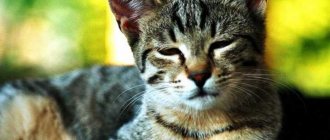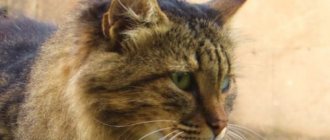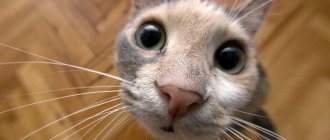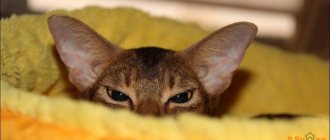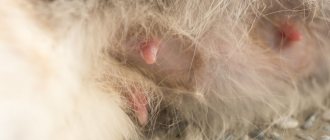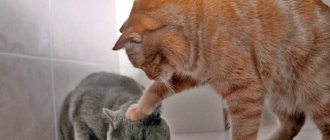Sleeping curled up
“I’m trying to sleep, but I’m not entirely comfortable.” This is exactly what the cat communicates when taking this pose. She curls up and puts her head on her hind legs. Although this position may seem incredibly comfortable and safe to a human, in reality the cat feels some anxiety and is trying to protect the most vulnerable parts of its body. The cat mainly hides its belly and wraps its tail around it. This position also allows the cat to better maintain a comfortable temperature, which is why she often sleeps like this in cold weather.
Why do cats touch noses?
Contents hide
A model of behavior familiar to all cat lovers, and not only them. You can often see two cats lightly touching each other's noses when they meet. Well, the owners of these animals almost daily feel the touch of a wet cat’s nose. What is this funny cat feature? Read the article.
Cats are recognized masters of communication. They have many different ways to share their mood, express a request or wish. Purrs are also known for their remarkable abilities. Today we are interested in the cat's outstanding sense of smell. It is less sensitive than that of dogs, but it is much superior in its capabilities to ours. The sense of smell is very necessary for purrs in everyday life, and not least for communication.
Cats are loners by nature. The only exception to the general rule is lions living in communities (prides). And other representatives of the glorious cat family feel great alone. But, no matter how you look at it, you still have to communicate.
Cats share scents. This is a signature cat technique: whiskers, touching their noses, share their unique signature smells with their relatives. At the same time, cats communicate without hostility - they study each other, equally putting themselves in a vulnerable position.
There is an expression: “It pokes like a blind kitten.” It fits perfectly: the kitten is blind, he is open to all dangers. The baby receives his first knowledge about the world around him through his nose - it is through his nose that he touches his mother for the first time. The kitten grows up quickly, but he remembers touching his nose - it was so good.
What happens next? And now the ritual is completed: the cats greet each other with their noses. Sometimes you can notice that friendly communication continues: one cat begins to rub its head and cheeks against the other in a friendly manner. Everything is within the limits so far: there is no hostility between the animals, they do not share territory, and mutual marking of odors has occurred. That's right: purrs use special scent glands located in the cheek area. But exactly the same glands are located on the hind legs; cats (especially those under stress) can use them too. The use of the hind legs in the ritual also indicates to us the dominant notes in behavior. We, people, cannot understand this (although some individuals, by the way, like to wave their legs, asserting their own superiority).
What if the cat touched its owner’s nose? Nothing bad or scary happens: the pet greets you in the same way. You can respond by touching your own nose (if you don't feel disgusted) or your finger - it doesn't matter. Touching noses, in any situation, is regarded by cats as a polite form of greeting.
Surely among your friends there are convinced cat lovers. When going to visit them, after saying friendly words of greeting to the owners, do not forget to say hello to the furry pets. Just sit down on your knees and extend your palm - preferably at the level of the animal's nose. This is your “hello”, said in cat language. Do not do such experiments if your friend drives a lynx, a leopard, or something worse - they may not understand you. Touching noses is definitely a friendly gesture and understandable in the cat world, but we cannot vouch for your safety.
If, as a response gesture, the cat came as close as possible, and even lightly butted you with its head (kittens are looking for their mother in order to ask her to nurse and caress her) - know: a friendly disposition has already been achieved. You can move on to the next level of acquaintance.
Based on materials from : Why Do Cats Touch Noses? Source: cuteness . com . Photo: zooteam . info (from open sources).
Sphinx pose
The position of the sphinx (the cat lies on its stomach, with its paws tucked under itself and its head raised) means that the animal is quite happy with its surroundings and its place of stay, and enjoys the situation to the fullest. The cat is not going to run away, because it does not see any threat. Rather, she feels completely safe and happy. This position also helps your pet save energy.
Sleeping on your back
The abdominal area is one of the most vulnerable parts of any cat's body. So, if your furry friend sleeps on the sofa with his belly up, with his paws scattered in different directions, he is telling you that he trusts you completely, for which you can be congratulated. This means that you deserve to be liked. This sleeping position is the most common among pets. But cats that live outside rarely experience such a strong sense of trust in the environment.
Behavior of domestic cats
The cat is a very intelligent and independent pet that was domesticated by humans many centuries ago. However, as in former times, representatives of the cat family value their freedom most of all. Having lived side by side with people for centuries, this intelligent pet has adapted to humans and learned to serve him faithfully.
Start understanding your cat perfectly
A domestic cat, through its behavior, lets its owners know what its desires are and its mood. If the cat owner knows the signals of the cat's language, then he will understand all the movements, facial expressions and sounds that his pet makes without words. It is difficult to find another pet that would have such a colossal arsenal of expressing its feelings and desires.
If a cat becomes scared, it bends its ears back and presses them to its head. At the same time, she crouches to the ground, sometimes completely clinging to it. And if she became very scared, then the pupils of her eyes become much wider, and the hair on the back of her neck stands on end. In some cases, the fur may rise up all over the body, which visually creates a larger volume of the cat's body. This is an evolutionary mechanism that has been developed over millions of years of existence of this species of animal, and its purpose is to intimidate the enemy with its large size.
The cat flattens its ears - you should be careful
If the cat sees that the threat was not fleeting, then it goes into the stage of active defense and tries to intimidate its enemy as much as possible. She extends her claws and begins to strike actively with her forelimbs in the air, demonstrating her aggressiveness and speed. At the same time, she begins to hiss loudly, but at the same time she is always ready to quickly leave the place of conflict.
Feeling fear, the cat rears up
One feature of the cat's behavioral traits should be noted: despite the fact that it considers its owner and other people living next to it to be its relatives, it at the same time realizes that it depends on people. She understands that by being close to a person, she thereby provides herself with additional protection, security and inviolability of the territory that she considers her own. Living next to human habitation, the cat will always be provided with food. This will relieve her of the need to hunt, which she would have to do in natural conditions to feed herself and her offspring. We can say that proximity to a person provides this animal with something like a cat’s pension, prolonging its life and providing additional security.
A cat is always aware of its dependence on a person
Freed from the need to worry about their food, cats give their affection to their owners, play with them and give them the maximum of their feline attention, which makes their owners so happy. At the same time, they jump into the arms of their owner, arch their backs, purr, rub against him lovingly, exposing their head and back for affection. There are many ways in a cat’s arsenal to show her attitude towards her owner, and if she is sick, she can trust him.
Cat owners have often noticed how happy their pet is when they step on the threshold of their home. The cat runs towards its owner, gently rubs against his legs and purrs loudly. However, many do not realize that this is not just an instinct, but a whole ritual that gives the cat no less pleasure than its owner.
If a cat is very excited or feels very threatened, confused or afraid, then it arches its back in an arc on which the fur stands on end.
However, such friendliness extends mainly to its owners. In relation to other cats, she is a great individualist and strives to communicate with them only during the mating season.
Cat shows claws in extreme cases
Just like other animals, a cat has its own territory in which it can feel proud and independent. Even cats that do not have their own home and owner do not wander anywhere, and those that live in natural conditions sometimes conquer a territory of up to one hundred hectares of field or forest. As for those cats that live in the city, they consider the garden or home of their owners to be their personal territory. At the same time, from time to time they carry out a kind of “revision” of this territory.
All animals that she considers strangers will definitely be expelled from this territory with all possible aggression on the part of the owner of the territory.
Knowing the psychology of a cat will make it easier for you to understand its behavior.
Considering this feature of cat psychology, the owner of the animal must ensure that the territory controlled by his cat is free from poisonous plants, broken glass, razors and other unsafe rubbish. It should be remembered that a cat that defended its territory was subjected to enormous stress, after which it can “move away” for a very long time. To make this process easier for her, the owner must take her in his arms, feed her something tasty, something that she especially loves, and then the cat will soon become playful again, as before, and give her owner many wonderful moments, purring at her. on his knees. Believe me, these minutes will remain in your memory for a long time!
If you find an error, please select a piece of text and press Ctrl+Enter.
Sleeping with half-closed eyes
No matter how cute and domesticated your cat may be, she is still a predator at heart. Cats remain alert to everything that happens around them, so they have to fight the urge to doze off and settle into a more comfortable position. This way they stay alert. If your cat sleeps with one eye open, it means that one part of her brain is asleep and the other is awake.
Sleeping on your side
This is one of the most comfortable positions a cat can assume. She feels completely safe, so she has no need to protect her vital organs. The cat is probably sleeping deeply and not worried about anything at all. Purrs who sleep in this position usually have a strong emotional connection with their owners and are not afraid to show trust.
Tail as a mood indicator
Cat gestures with a moving, flexible tail are very expressive. Even in restrained animals that weakly express their emotions in other ways, the tail is a real indicator of mood. Observant owners highlight the following basic meanings of cat gestures with their tail:
- A drooping tail means fatigue, dissatisfaction or disappointment.
- Tail between legs - fear, resentment.
- A “pipe” tail indicates that the cat is in a good mood, full and happy with everything.
- Twitching of the tail expresses dissatisfaction, irritation or warning. An increase in the amplitude of movements along the entire length, blows with the tail on the sides - increasing tension, in this case the owners should be careful and leave the animal alone for a while.
- Moving the tip of the tail indicates interest.
- A fluffy, high or curved tail signals aggression.
- Hitting the floor with the tail - anger or the excitement of the hunt.
Cat tail gestures are not only intended for owners, but are also one of the main ways of communicating with members of their species.
Sleeping curled up in a ring
This is also one of the most common poses among domestic cats. This position is convenient as it helps maintain heat in the body and at the same time protect the most sensitive areas. If your cat sleeps curled up, she feels safe and completely relaxed. But be careful! Sometimes cats adopt this position when they feel pain due to certain health problems. Pay attention to your pet's behavior so you don't miss any warning signs.
The language of cat poses
Cat owners know that their pets have a very capricious character. This feature is very clearly revealed when the owner makes the mistaken decision to play with them at the wrong time. Depending on the feeling of security and comfort, the cat's mood can change dramatically at any second. To be prepared for the different states of mind of your pet, we advise you to familiarize yourself with the main options for cat poses...
Relaxed
When cats lie stretched out on their side in a relaxed position, they feel safe and there is no need to be on guard. In this position, they go into deep sleep, a sure sign of which is twitching of the limbs.
Happy
Cats can show their happiness in various ways. They can sit upright and observe their surroundings. Or they can lie with their paws tucked, reminiscent of the Sphinx’s pose: the head is straight, but the state is relaxed, without signs of aggression.
Focused
When a cat is in the process of hunting, its entire body is focused on the object. Its prey can be a toy, an insect or a mouse. The cat's body is pressed low to the ground, and its hind legs are tucked in - the predator is preparing to jump.
Naughty
Cats show their playfulness by wriggling in different directions and rolling on their backs. They may start meowing, trying to get your attention to start playing. Cats are trying to show you that they are harmless and looking for a fun time.
Confident and satisfied
The cat lies on its back, and its open belly indicates a sense of confidence and security in its environment. But in this position he can defend himself if necessary. Even in a prone position, all four paws are ready to attack. Those who try to stroke the cat's belly in this position will be severely punished with bites and claws.
Neutral
Cats spend most of their day in this position. They can simply lie curled up in a ball. There is no tension in the body, they are relaxed and in this position they can happily observe what is happening around them.
Cautious
An arched back is the first sign that a cat is afraid of something. The fur stands on end, and thus they try to take on a more intimidating appearance, to appear larger in size. They view something in their environment as a threat and use this position as a way to protect themselves. They are ready to strike at any object that scares them.
Alarming
If a cat's head is low to the ground and her ears are flat, she will experience anxiety and feel cornered. Cats group themselves into a small ball, trying to make themselves smaller than they really are.
Uninhibited
A cat's body language may indicate feelings of fear or anxiety through physical changes: either a defensive curl or an arched back. But by stretching, they relieve their tension, which constrained their body during times of danger. This is a sign that they feel relieved and are no longer anxious about the situation. But this pose may just be a stretch after waking up.
Friendly
Unfortunately, cats do not want attention from their owners as often as they would like.
But sometimes even the most obstinate cat needs it. By arching its back and rubbing its head against your legs, the cat announces its friendly mood. Its fur is straightened, showing that the animal is not alarmed and is waiting for your touch. link
Covers its face with its paw
Cats don't like to be disturbed, and this attitude is a clear sign that you should leave your cat alone. If your meow tries to cover its head with its paw or tail, and also shows irritation when you touch it, then most likely it craves peace and quiet. Just let your cat enjoy his own time and space, and save the sussies for later.
By observing your cat while she sleeps, you can understand what your pet lacks, what worries her and how you should behave with her. If your pet is not behaving as usual, then this is a reason to contact a veterinarian. By the way, useful conclusions can also be drawn from the meowing of cats.
Photo source: Pixabay
How to understand what hurts a cat, tips for cat lovers
How to understand what is hurting a cat.
How to understand what hurts - Pain appears as a result of stimulation of special nerve endings.
Pain is one of the earliest signs of the spread of the disease. Pain can occur for various reasons, it can be poisoning , bruise , infection, inflammation.
When we feel pain, we can tell someone about it, consult a doctor. A cat cannot speak and we need to learn to recognize your cat's reaction to pain.
♦ A cat will meow if you accidentally step on its healthy paw. If you touch or accidentally step on a sore spot, your cat may hiss, bite, or even lunge at you. This should serve as a kind of bell for you, you need to calm the cat and examine its paws.
♦ If the cat is limping and does not step completely on its paw, or does not get up at all when you call, or tucks its paw under itself, all this signals that its paw hurts.
♦ If your cat meows pitifully when she gets up or lies down, then she may be suffering from joint pain (for example, arthritis ).
♦ Irritation or pain in the anal glands causes the cat to wiggle its butt on the ground. She also constantly examines the sore spot and licks it.
♦ Pain in the eye causes your pet to paw at it or rub it against something.
♦ If the ear hurts , then the cat tilts its head, trying to press the sore ear to the ground, or it often shakes its head.
♦ If the pain is hidden in the oral cavity , then the cat may drool, and the jaw may tremble slightly.
If the cat suffers from back pain or headaches, then it is much more difficult to determine this. Sometimes the only sign of discomfort may be a subtle change in her behavior.
A cat has back pain if:
♦ She is limping, but her limbs are intact. ♦ Snarls when you stroke her back. ♦ Shakes when standing up and/or arching your back. ♦ Suffering from incontinence. ♦ When defecating, he has difficulty standing on his paws. ♦ Periodically settles on the back of the body.
A cat has a headache if:
♦ She squints her eyes, although there is no obvious reason for this. ♦ Presses the top of the head against various objects. ♦ Periodically shakes his head. ♦ Looks at you blankly.
A cat has pain in the internal organs if:
♦ The cat spends most of its time lying down. ♦ Behaves restlessly, cannot sit in one place for a long time. ♦ Constantly tenses abdominal muscles or stands in a hunched position. ♦ Frequently strains, but cannot have a bowel movement. ♦ Becomes aggressive and irritable, does not let anyone near her.
Health to you and your pets.
Source; "Your Cat's Health" No. 8 (2011)


